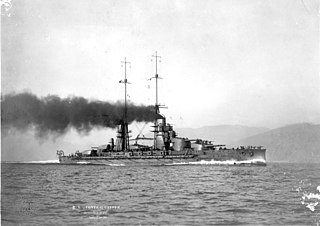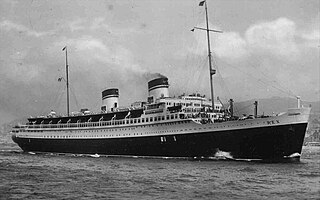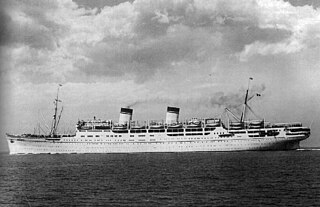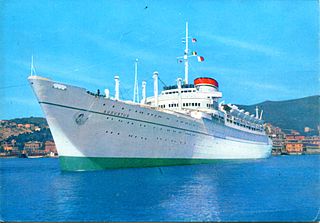
Giulio Cesare was one of three Conte di Cavour-class dreadnought battleships built for the Royal Italian Navy in the 1910s. Completed in 1914, she was little used and saw no combat during the First World War. The ship supported operations during the Corfu Incident in 1923 and spent much of the rest of the decade in reserve. She was rebuilt between 1933 and 1937 with more powerful guns, additional armor and considerably more speed than before.

The Conte di Cavour–class battleships were a group of three dreadnoughts built for the Royal Italian Navy in the 1910s. The ships were completed during World War I, but none saw action before the end of hostilities. Leonardo da Vinci was sunk by a magazine explosion in 1916 and sold for scrap in 1923. The two surviving ships, Conte di Cavour and Giulio Cesare, supported operations during the Corfu Incident in 1923. They were extensively reconstructed between 1933 and 1937 with more powerful guns, additional armor and considerably more speed than before.

SS Rex was an Italian ocean liner launched in 1931. She held the westbound Blue Riband between 1933 and 1935. Originally built for the Navigazione Generale Italiana (NGI) as SS Guglielmo Marconi, its state-ordered merger with the Lloyd Sabaudo line meant that the ship sailed for the newly created Italia Flotta Riunite.

CP Ships was a large Canadian shipping company established in the 19th century. From the late 1880s until after World War II, the company was Canada's largest operator of Atlantic and Pacific steamships. Many immigrants travelled on CP ships from Europe to Canada. The sinking of the steamship RMS Empress of Ireland just before World War I was the largest maritime disaster in Canadian history. The company provided Canadian Merchant Navy vessels in World Wars I and II. Twelve vessels were lost due to enemy action in World War II, including the RMS Empress of Britain, which was the largest ship ever sunk by a German U-boat.

SS Manhattan was a 24,189 GRT luxury ocean liner built for the United States Lines, named after the Manhattan borough of New York City. On 15 June 1941 she was commissioned as USS Wakefield (AP-21) and became the largest ship ever operated by the US Coast Guard. In 1942 she caught fire and was rebuilt as a troop ship. Post-war, she was moored in New York in May, before decommissioning in June 1946. She was laid up in reserve at Jones Point, New York. She never saw commercial service again, and was sold for scrap in 1965.

SS Conte Grande was a Lloyd Sabaudo ocean liner built in 1927 by Stabilimento Tecnico Triestino in Trieste, Italy, to service the transatlantic passenger line between Genoa, Italy, and New York City. Launched on 29 June 1927, her maiden voyage was from Genoa to Naples to New York City, which occurred on 13 April 1928. In 1932, after acquisition by the Italian Line, she was transferred to the South America service but was laid up in Santos, Brazil in 1940.

SS Conte Biancamano was an Italian ocean liner launched in 1925. The name was chosen in honor of Humbert I Biancamano, founder of the Savoy dynasty. She was built in the Scottish shipyard William Beardmore & Co. in Dalmuir, near Glasgow. She was built for the Genovese shipping company Lloyd Sabaudo, operator of Conte Rosso and Conte Verde. The engine, equipped with two steam turbines double reduction unit and two propellers, allowed her to reach a speed of 20 knots, and vented in two funnels. She housed 180 passengers in first class, 220 in second class, 390 in economic class and 2,660 in third class.

Conte Verde was an Italian ocean liner active in the early 20th century.

USS Aeolus (ID-3005), sometimes also spelled Æolus, was a United States Navy transport ship during World War I. She was formerly the North German Lloyd liner SS Grosser Kurfürst, also spelled Großer Kurfürst, launched in 1899 that sailed regularly between Bremen and New York. At the outset of World War I the ship was interned by the United States and, when the U.S. entered the conflict in 1917, was seized and converted to a troop transport.

SS Orsova, was a British ocean liner, built by Vickers Armstrong in Barrow-in-Furness, England, for the Orient Steam Navigation Company for their Great Britain-to-Australia services via the Suez Canal. She was the final development of the 28,000 ton class which began with the SS Orcades of 1948 and continued with the SS Oronsay of 1951. In 1960, in conjunction with the introduction of the new larger and faster Oriana and Canberra, the fleets of Orient and P&O were combined as P&O-Orient Lines, although the Orient ships retained their corn-coloured hulls and sailed under their own house flag. In 1966, P&O acquired the balance of the Orient shares and the Orient Line was discontinued, with Orsova and her fleet mates being transferred to the ownership of the Peninsular & Oriental Steam Navigation Company (P&O), painted white and under the P&O houseflag.

SS Prinz Friedrich Wilhelm was an ocean liner for North German Lloyd (NDL) from her launch in 1907 until the end of World War I. After the war, she briefly served as USS Prinz Friedrich Wilhelm (ID-4063) for the United States Navy returning American troops from France. The vessel was first chartered—and later purchased outright—by Canadian Pacific Steamships (CP) and operated under the names Empress of China, Empress of India, Montlaurier, Monteith, and Montnairn. She was scrapped in 1929.

The American Palestine Line was a steamship company, formed in 1924 in the U.S., for the purpose of providing direct passenger service from New York to Palestine. It was reportedly the first steamship company owned and operated by Jewish people. The company negotiated to purchase three ocean liners from the United States Shipping Board, but it was only able to purchase one, SS President Arthur, a former North German Lloyd steamer that operated as Princess Alice before being seized by the United States during World War I. After refurbishing the liner, the company inaugurated service between New York and Palestine in March 1925, when President Arthur sailed on her maiden voyage. A crowd of 15,000 witnessed ceremonies that included songs, prayers, and speeches in English and Yiddish. The company claimed that President Arthur was the first ocean liner to fly the Zionist flag at sea and the first ocean liner ever to have female officers.

MS Augustus was a 27,090 GRT, luxury ocean liner built in 1950 for Italian Line. She was the sister ship to MS Giulio Cesare that was launched in the same year. These two ships were built to the same design, with similar specifications. After the Augustus was sold to Hong Kong, she sailed under five names. The ship was later sold to Manila Hotel and renamed MS Philippines, functioning as a static hotel. As reported by both Maritimematters, and maritime, the MS Philippines was sold for scrap in September 2011. As of December 2011, she was beached in Alang for scrapping.

SS Duilio was the first Italian super ocean liner and one of the largest Italian merchant ships until 1925. She measured 24,281 gross register tons and was the sister of the SS Giulio Cesare, which was launched in 1921. She was constructed for the Italian shipping company “Navigazione Generale Italiana” based in Genoa and constructed by Ansaldo Shipyard owned by Sestri Ponente. She was sunk on 10 July 1944.

MS Giulio Cesare was a luxurious ocean liner built for the Italian Line. She was a sister ship to MS Augustus which was launched in the same year. She was built for the South America service like her sister. These two ships' specification and design were very similar.

SS Santa Rosa was a passenger and cargo ocean liner built for the Grace Line for operation by its subsidiary Panama Mail Steamship Company of San Francisco. She was the first to be launched and operating of four sister ships, the others in order of launch being Santa Paula, Santa Lucia and Santa Elena. All four ships, dubbed "The Four Sisters" and "The Big Four" were noted as the finest serving the West Coast and were of advanced technology. All served in World War II as War Shipping Administration (WSA) troop ships. Both Santa Lucia and Santa Elena were lost in air and torpedo attacks off North Africa.

SS Santa Paula was a passenger and cargo ocean liner built for the Grace Line. She was the second of four sister ships ordered in 1930 from the Federal Shipbuilding and Drydock Company of Kearny, NJ. Her regular service route included inter-coastal service between the east coast and the west coast of the US via the Caribbean and the Panama Canal. She later sailed on cruises from New York to the Caribbean and South America. She was the second of three vessels to bear the name Santa Paula for Grace Line service.

SS Sirius was a Norwegian iron-hulled steamship built in Germany in 1885. Sirius spent over 55 years sailing with cargo, regular passengers and tourists between Norway and Europe, and on the Norwegian coast. In 1894-1895, she served a year on the Hurtigruten route on the coast of Norway, before reverting to her former duties.

MV Saturnia was an Italian ocean liner named after Saturnia, Tuscany, the first of two sister ships built in Trieste for Cosulich Soc. Triestina di Nav. of Trieste and launched in 1925. Sister ship MS Vulcania was launched the next year. Saturnia served into World War II for Italy and upon the Italian armistice with the Allies was delivered to the U.S. War Shipping Administration (WSA) in an arrangement made between Italy and Admiral Cunningham of the Royal Navy, approved by General Eisenhower.

A. H. Bull Steamship Company was a shipping company and passenger liner service founded in New York City in 1902 by Archibald H. Bull (1848-1920). Service started with shipping between New York and Florida. His fleet of ships then added service to other Eastcoast ports. The company is also often called the Bull Lines and the Bull Steamship Line or A. H. Bull & Company. While founded in New York, Bull soon move its headquarter to Peir 5 in Baltimore, Maryland. Bull Lines main Eastcoast ports were: Baltimore, Charleston, Philadelphia, Tampa and Norfolk, Virginia. Oversea ports: Porto Rico, Antwerp, Bordeaux, Hamburg, Bremen, Copenhagen, and West Africa. Bull Steamship Line supported the US war effort for both World War I and World War II, including the loss of ships.
























